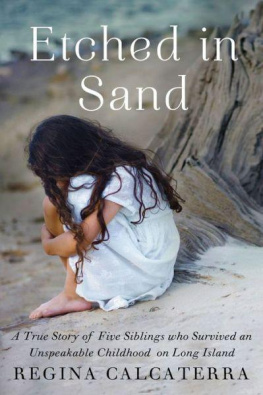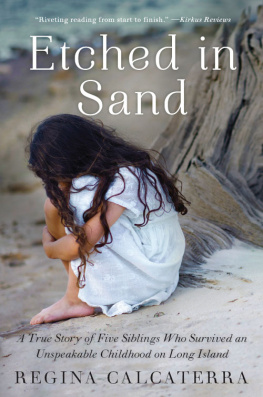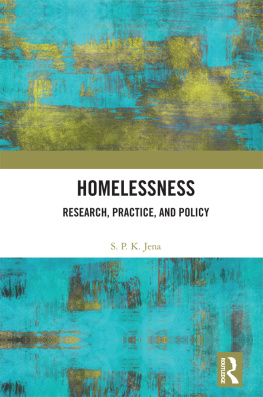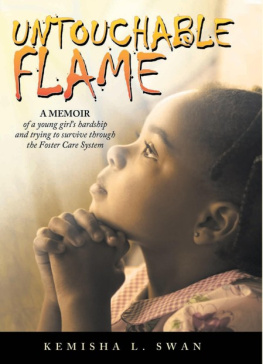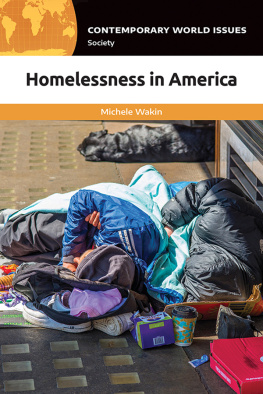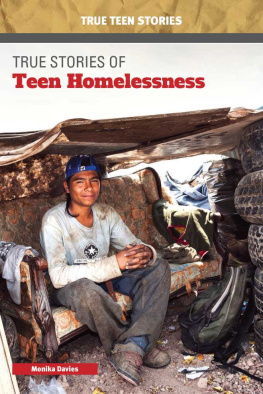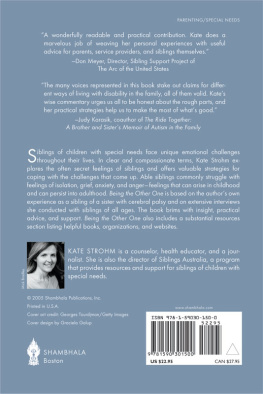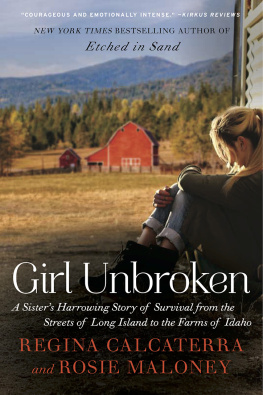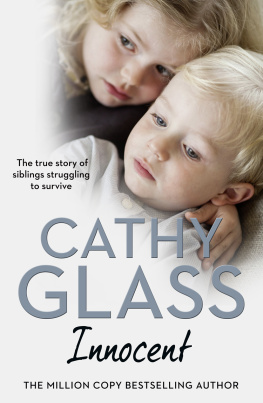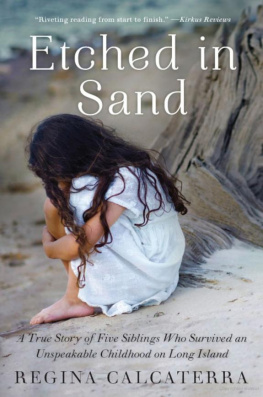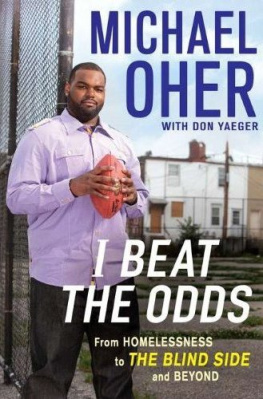To Cherie, Camille, Norman, and Roseanne
may we always continue laughing and dancing, together.
To the hundreds of thousands of children in the U.S.
who are either abused, in foster care, or homeless.
The journey is long and often dark but you must believe
in your lightyou have so much to offer.
Contents
E TCHED IN S AND is the true story of the experiences I shared with my siblings from our childhood to the present day. My siblings consented to the publication of Etched in Sand and the use of their proper names in the forthcoming pages. However, some peoples names have been changed in order to protect their anonymity, including but not limited to past foster parents and relatives both living and deceased. Specifically worth noting is the name change of the character represented as my biological father, whom I refer to with the pseudonym of Paul Accerbi. For ease of description, my many social workers were consolidated into a few characters and are represented with pseudonyms as well. Also changed is the town that my younger siblings resided in when in Idaho.
I HADNT SEEN New York City this still since 9/11. Lower Manhattan was a ghost townthere were no planes in the sky, no boats on the East River, no buses, no trains rumbling in the subway. This was Wall Street, normally the most bustling street in the world... but where I stood at the Wall Street Heliport, I was the only one present.
Because there was no traffic on my drive from Long Island to Manhattan, I was the earliest to arrive for the first official helicopter flyover after Hurricane Sandy. Soon everyone began to emerge from their vehicles: the governor of New York State, Andrew Cuomo; New Yorks two United States senators, Chuck Schumer and Kirsten Gillibrand; senior gubernatorial cabinet officials; and my colleagues from Nassau and Westchester Counties. We greeted one another in a manner both solemn and cordial, taking note of how a tragedy makes professional interactions seem much more personal. Wearing jeans, windbreakers, and boots, we exchanged details of the storm, our objective intensely clear. It was up to us to try and heal this region after Sandys destruction.
Within moments three military helicopters broke through the fog as assured as eagles. With the press and security now present, there were a couple dozen of us, all standing quietly as the copters whipped the vinyl of our coats and finally touched down on the pad. I felt a collective awareness among us that not even the roar of the propellers could cut through the heaviness of that morning. It struck me as one of the eeriest moments in my life: The silence was actually louder than the noise.
As the chief deputy executive of Suffolk County, I waited my turn to climb into the helicopter and by chance wound up in a seat that would give me a solid view of Long Island after we surveyed the damage in New York City. We took the military aviators instructions and placed the headphones over our ears. When the helicopter took off for Breezy Point in Queens, where a fire had ravaged a neighborhood during Sandy, the silence loomed again. Blocks of homes were charred. Families had lost everything. For me to have been managing the storm crises in Suffolk County while hearing the reports of how these Queens residents were trying to escape the area was one thing. Now to witness the damage where homes and lives had been destroyed was a completely surreal moment.
My heart pounded as we neared Suffolk and I prepared to address my countys devastation for this group of elected officials I respected so greatly. Which town in Suffolk had the most damage? one of them asked.
I hurried to push the microphone button on the headset as our aviator had shown us. Lindenhurst, I answered. The group nodded and gazed back out the window, as though they understood why Lindenhurst holds a special significance to me: Its where I was born. Its also the place where three decades later, I learned my background from family Id never known existed. My mother left behind scorched earth with the same totality that Mother Nature had swept my island. For years, Suffolk County transported me back to the pain and darkness my four siblings and I endured throughout our fatherless childhoods with a profoundly troubled mother. Now, as I examined it from the sky, my emotions swelled with a love for this placehow the experiences of growing up here made me who I am. Hovering above as a leader in the aftermath of Sandy struck me deeply. Aside from the love I shared with my siblings, this county was our only sense of homea place that did its best to protect us from the unpredictable. I never could have imagined that one day Id be called on to return the same security.
W HAT DREW ME to a career in public service was my appreciation for governments purpose: Its the body that decides who receives which resources, and how much of them. My childhood on Long Island gave me a very personal awareness for how people in power can impact the lives of others. Growing up here I faced extraordinary struggles that would have tested any childs strength and endurance. Somehow, with optimism and determination, my siblings and I could usually manage to find someone who was willing to lift us to help.
My cast of resolute characters is composed of my older sister Camille, who is forever my closest confidante; and our three siblingsCherie, the eldest, who found escape from our childhood in a teen marriage; Norman, fourth in birth order just behind me; and our youngest sister, Rosie. As a scrappy pack of homeless siblings wandering the beach communities of Long Island, sometimes wed sneak off to the Long Island Sound or the Atlantics shorethe wild, windy places where it didnt matter who we were, what we wore, or how tousled we appeared. With our hands and empty clamshells as our tools, wed build sand castles by the water, or etch out all five of our names
Cherie Camille Regina Norman Rosie
and enclose each with a heart. Wed run, squealing, as the waves roared upon the shore and rolled back in rhythm, unsentimentally washing away our work. Then wed run back toward the water and create it all anew.
We didnt know it then, but that persistence would become the metaphor to predict how wed all choose to live our lives. No accomplishment has taken place without trial, and no growth could have occurred without unwavering love. This is the story of how it took a community to raise a child... and how that child used her future to give hope back.
Suffolk County, Long Island, New York
Summer 1980
T HE AREA WHERE we live sits between the shadows of the cocaine-fueled, glitzy Hamptons estates and New York Citys gritty, disco party culture. Songs like Devos Whip It and Donna Summers Bad Girls blast through the car courtesy of WABC Musicradio 77, AM. Gas is leaded and the air is filthy.
Long Island lacks a decent public transportation systemto get anywhere, you need either a car or a good pair of shoes. Our shoes arent the best.
Our car is worse.
My mothers thick arm rests on the drivers-side window ledge of her rusty, gas-guzzling Impalathe kind you buy for seventy-five dollars out of a junkyard. Her wild hair blows around the car as she flicks her cigarette into the sticky July morning. The ashes boomerang back in through my window, threatening to fly into my eyes and mouth in frantic gusts. Squinting tightly and pursing my lips hard, I know better than to mention it.
My seven-year-old baby sister, Rosie; our brother, Norman, whos twelve but still passes for an eight-year-old when we sneak into movie theaters; and meRegina Marie Calcaterra, age thirteen (personal facts Im well accustomed to giving strangers, like social workers and the police)are smooshed into the backseat. Like most of our rides, the car suffers from bald tires, broken mirrors, and oil dripping from the motor. If I lift up the mats, I can see the broken pavement move beneath us through the holes in the rear floor.
Next page
